A discussion of parts of check valve will be presented in this article. If you know what a one-way valve is, you can think of it as a check valve, non-return valve, retention valve, reflux valve, foot valve, or one-way valve that usually only allows one-way flow (liquid or gas).
It is called a two-port valve, meaning that it has two openings on its body, one for receiving fluid and one for releasing it. There are many types of check valves used in various applications around the world. Check valves are frequently found in everyday household items. Check valves come in a wide range of sizes and prices, but they are usually very simple, inexpensive, and small.
In general, most check valves do not require a person to operate them or any external control, and, therefore, there are no handles or stems on them. Plastic or metal are the most common materials for the bodies (shells) of check valves.
When considering check valves, cracking pressure is an important concept. This is the minimum difference between inlet and outlet pressure at which a check valve will operate. The check valve is usually designed to work at a specific cracking pressure and, therefore, can be specified.
Basics of Check Valves
The operation of check valves relies on three basic steps:
Cracking Pressure
It is necessary to have a minimum upstream pressure (pressure difference between inlet and outlet) in order to open a check valve. The minimum upstream pressure at which a check valve opens is known as the ‘cracking pressure.’ Depending on the valve design and size, the cracking pressure will vary. Make sure that your system is able to generate this cracking pressure and is suitable for the application.
Closing
A valve will close if the upstream pressure drops below the cracking pressure or if there is backflow (flow moving from the outlet to the inlet). Depending on the check valve design, the closing mechanism can change. Essentially, the backpressure forces a gate, disc, diaphragm, or ball against the orifice and seals it. There are two ways in which the closing process can be assisted: by a spring or by gravity.
Installation Orientation
A one-way valve can only operate in one direction, so knowing the installation orientation is crucial. On valve housings, there is often an arrow indicating the direction of flow. Other than that, you will require checking the flow direction of the valve. A backward connection will mean the flow cannot move through the system, causing pressure to build up and potentially damaging the system.
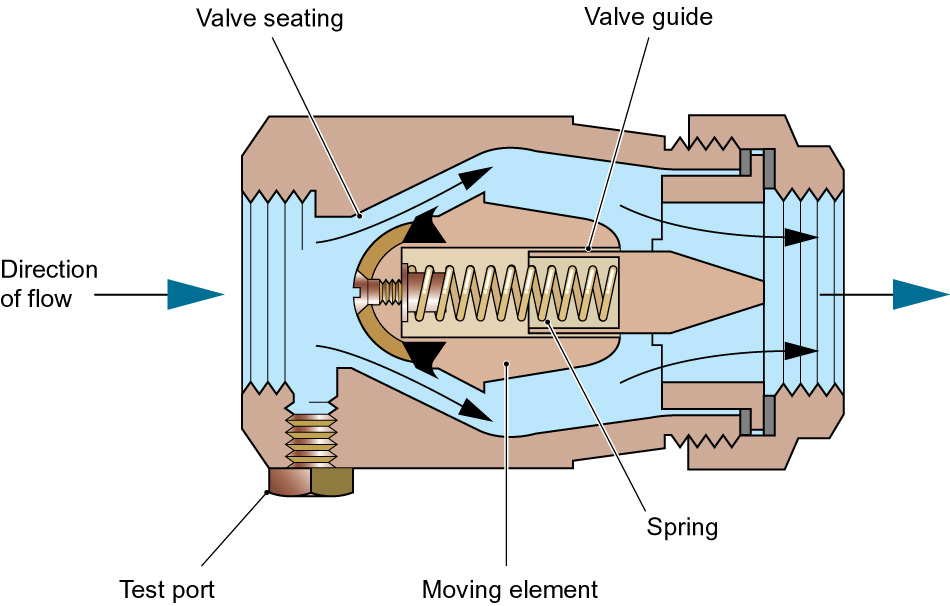
Read More o Linquip
- Parts of Sprinkler Valve
- Parts of Gate Valve
- Check Valve vs Backflow Preventer
- Everything You Need To Know About Check Valve Function
- Lift Check Valve: learn the basics, get the most out of it!
Parts of Check Valves
In pipes and similar devices and equipment, check valves are generally used to prevent a reverse flow by allowing materials or fluids to flow in only one direction. Despite their various forms, sizes, and functions, these valves generally operate based on the same principle. Most check valves have three main components:
Inward Port
The inward port allows gas or liquid to enter.
Valve Body
The material passes through the body.
Outward Port
The material (gas or liquid) can exit the device through the outward port.
Parts of Different Types of Check Valves
In order to regulate the flow of gases and liquids inward and outward, several technologies are employed. There are a number of parts that may look the same, but they are not interchangeable since the functions, sizes, and materials differ from one type to another. In this section, we will present various types of valves and their components or parts:
Single-Disc Check Valve
This design of this check valve has a disc closure that hinges at the top of the cap and is pushed open by the flow. When the flow reverses, it automatically closes. Because this type of valve gets pounded by constant flow reversals, it is not recommended for frequent reverse flow situations that wear out the disc easily. It is possible to set up the single-disc check valve either vertically or horizontally. However, a vertically mounted valve has a tendency to remain open when there is a gradual change in velocity. It is necessary to counteract this tendency with a lever or a counterbalance.
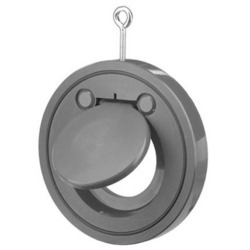
The Single-Disc check valve consists of four main parts:
- The body
- A disc
- A star guide
- A spring.
Double-Disc Check Valve
The double-disc check valve consists of two half-circular discs connected to each other. Forward flow causes them to fold together, and reverse flow causes them to close in a full circle. It is often installed between two flanges and is most commonly found in liquid dispensers. The reason for its popularity is that it is inexpensive and compact.
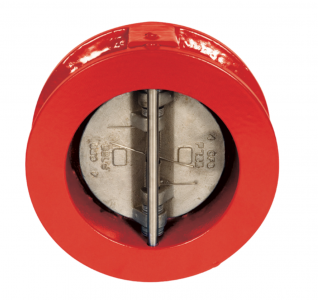
The main components of double-disc check valves are:
- Body
- Spring
- Front plate
- Discs
Ball Check Valve
Ball check valves are check valves with a ball as the closing member, i.e. the part that blocks the flow. A ball check valve may have a spring-loaded ball, which helps to keep it shut. If a spring isn’t used, the reverse flow must be used to move the ball into the seat and create a seal. Ball check valves have interior surfaces that are conically tapered to guide the ball into the seat and create a positive seal when preventing reverse flow.
The ball check valve is usually simple, inexpensive, and small. Typically, metal balls are used, but there are some cases in which other materials are used, such as sapphire, which is highly durable and inert. For both hardness and chemical resistance, HPLC pumps commonly use small inlet and outlet ball check valves with ruby balls and sapphire seats. However, for some other applications, both the ball and seat may be made of ruby.
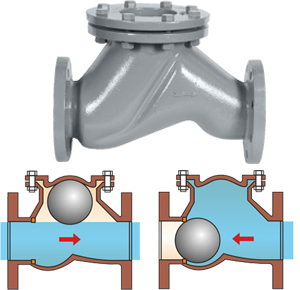
Ball check valves typically consist of the following parts:
- Ball
- Body
- Gasket
- Cap
- Clamp.
A worn-out or cracked seat on such a check valve can eventually lead to its need for replacement after prolonged use. These types of valves are therefore made to be replaceable and may have a plastic body that is tight-fit inside a metal fitting that is strong enough to carry high pressure and which is attached to the pump head.
Ball check valves are different from ball valves, which contain a rotor that can stop or direct flow.
Diaphragm Check Valve
The diaphragm check valve consists of a flexible rubber diaphragm that closes the valve when flexed. Flow through a check valve is allowed when the pressure upstream exceeds the pressure downstream by a certain amount, known as the differential pressure. In the event that positive pressure stops, the diaphragm will automatically return to its original position.
In the following figure, you can see the main components of a diaphragm check valve.
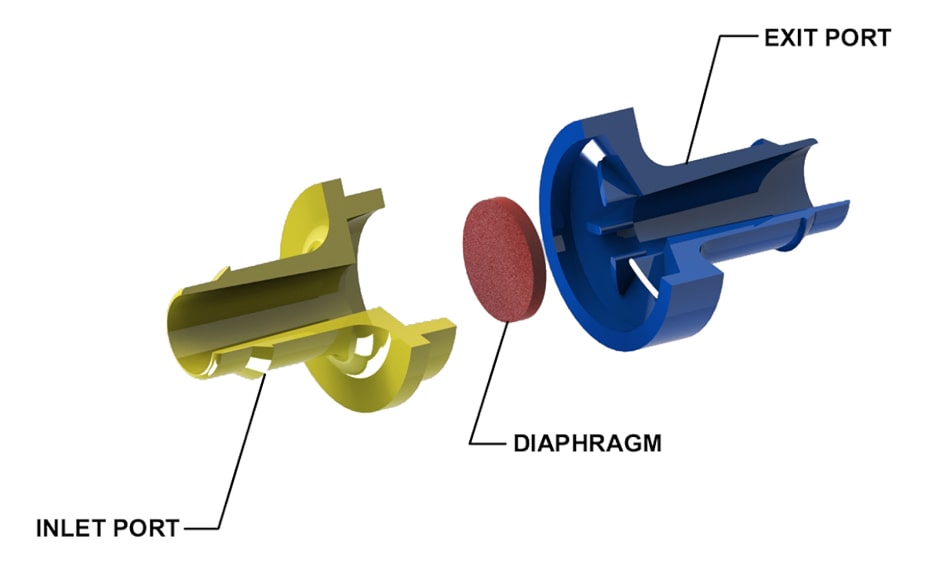
Stop Check Valve
Check valves with override controls stop flow no matter what is the direction or how much is the pressure of the flow. Check valve behavior includes closing when backflow occurs or when enough forward pressure is not present, but it can also be shut deliberately by an external mechanism, forbidding any flow whatsoever even when forward pressure is present.
According to the figure below, stop check valves are composed of the following parts:
- Actuator
- Stem
- Bonnet
- Body
- Disc
- Seat
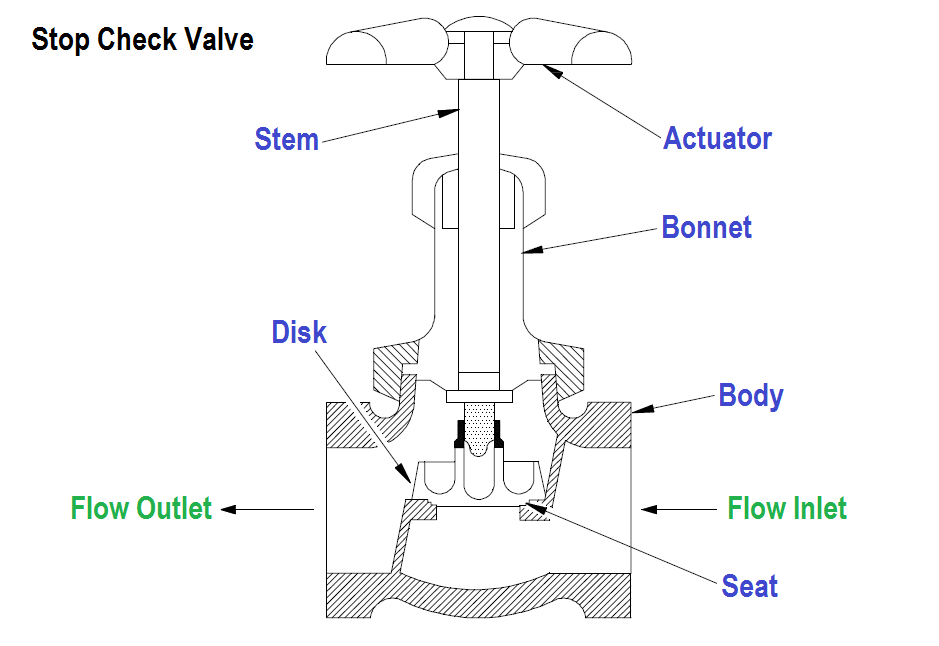
Lift-Check Valve
In the lift-check valve, when the disc, also called the lift, is lifted off its seat due to a higher level of inlet or upstream pressure, the valve can allow fluid to flow from the outlet or downstream side. Discs are guided along a vertical line so they can later be appropriately reseated. By gravity or higher downstream pressure, the disc will lower to its seat when the pressure is no longer higher, closing the valve to prevent the reverse flow.
A lift-check valve consists of the following parts:
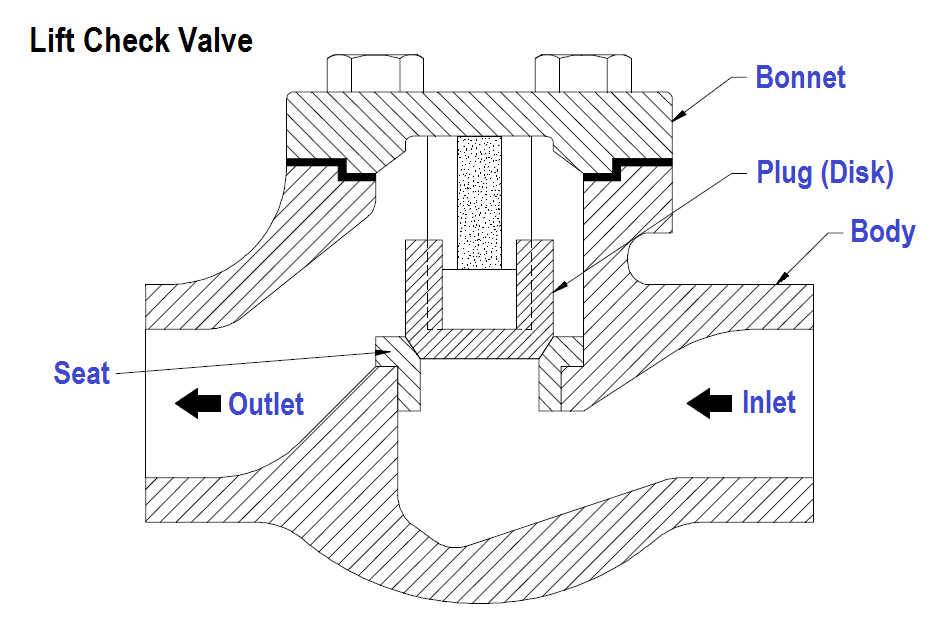
In-Line Check Valve
In-line check valves are similar to lift check valves. Typically, an in-line check valve has a spring that lifts when pressure is applied upstream of the valve. ‘Cracking pressure’ is the pressure required to overcome the spring tension on the valve’s upstream side. In order to prevent back-flow during the cracking process, the valve will automatically close when the pressure going through it falls below the cracking pressure.
Duckbill Check Valve
Duckbill valves are check valves constructed from rubber or synthetic elastomers and have two (or more) flaps that resemble the beak of a duck. They are often used in medical applications to avoid backflow contamination.
The valve is positioned at one end on the outlet of the supply line, where it conforms to the shape of the line, which is typically round. At the other end, the duckbill has a flattened shape. Fluid is flowed through the supply line and, therefore, through the duckbill when the flattened end opens and permits the pressurized fluid to pass through. However, when pressure is removed, the duckbill end flattens again, preventing backflow.
The duckbill valve works similarly to the mitral valve in the heart.
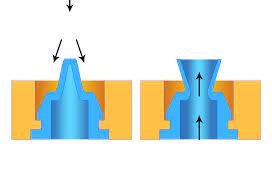
Pneumatic Check Valves
A pneumatic non-return valve is used in situations where a normal non-return valve is ineffective. This might apply, for example, where floodwater enters a site, but there’s also the risk that polluting substances will leave it and pollute the environment.
Non-return valves have a pneumatic lock in the event of a spill. These non-return valves are installed in the ground and can be pneumatically locked closed.
Pneumatic non-return valves are commonly used to lock sites when chemicals or hazardous waste are being loaded or transferred. Pneumatic non-return valves are more durable than pneumatic bladder systems.
Reed Check Valve
Essentially, a Reed valve is a check valve that uses a flat flexible sheet sealing an orifice plate. It is characterized by low cracking pressure, a light moving part, moderate flow resistance, and a seal that improves with backpressure. These valves are commonly used in two-stroke internal combustion engines as their air intake valve for the crankcase volume. Also, the reed check valves in air compressors are found as both the intake and exhaust valves for the cylinder(s).
The following figure shows the schematic diagram of the parts of a reed valve.
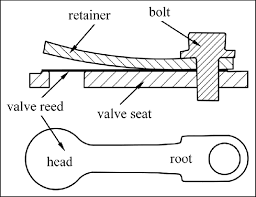
While reed valves are commonly used for gases instead of liquids, some designs of water treatment control valves utilize the sealing characteristic, selectively forcing some of the reeds open to create a flow path.
Piston Check Valve
Piston check valves function very much like lift check valves. This device has a dash-pot containing a piston and a cylinder designed to provide a cushioning effect during operation. Piston check valves have similar flow characteristics to lift check valves because of their similar design.
Parts of a piston check valve are:
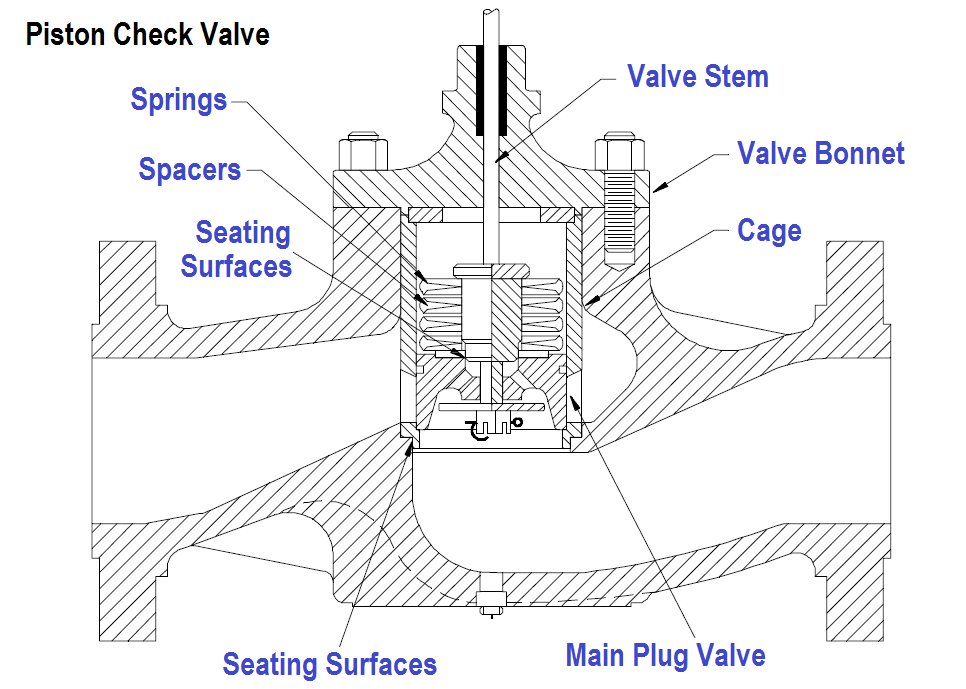
The piston check valve is used most often in conjunction with globe and angle valves in piping systems where flow directions change frequently. This type of valve is often found in water, air, and steam systems.
Flow Check Valve
In a hydronic heating or cooling system, a flow check prevents unwanted passive gravity flow. The flow check is a basic gravity-closed, flow lifted heavy metal stopper designed to have low flowing resistance, long service life, and enable the surfaces of the seal to self-clean particles and debris found in hydronic systems.
Typically, the stopper is not conical to enable self-cleaning. A common design is an orifice rim with circular recesses that go over a narrow ridge on the weight. It does not require a perfect seal since the application itself tolerates a modest rate of reverse leakage. Flow checks are operated by a screw to hold the valve open, opposite to a stop-check valve which assists in filling the system and removing air from it.
Read More o Linquip
- Check Valve Manufacturers
- Plug Valve Manufacturers
- Gate Valve Manufacturers
- Air release valve Manufacturers
- Valve Manufacturers
Buy Equipment or Ask for a Service
By using Linquip RFQ Service, you can expect to receive quotations from various suppliers across multiple industries and regions.
Click Here to Request a Quotation From Suppliers and Service Providers



